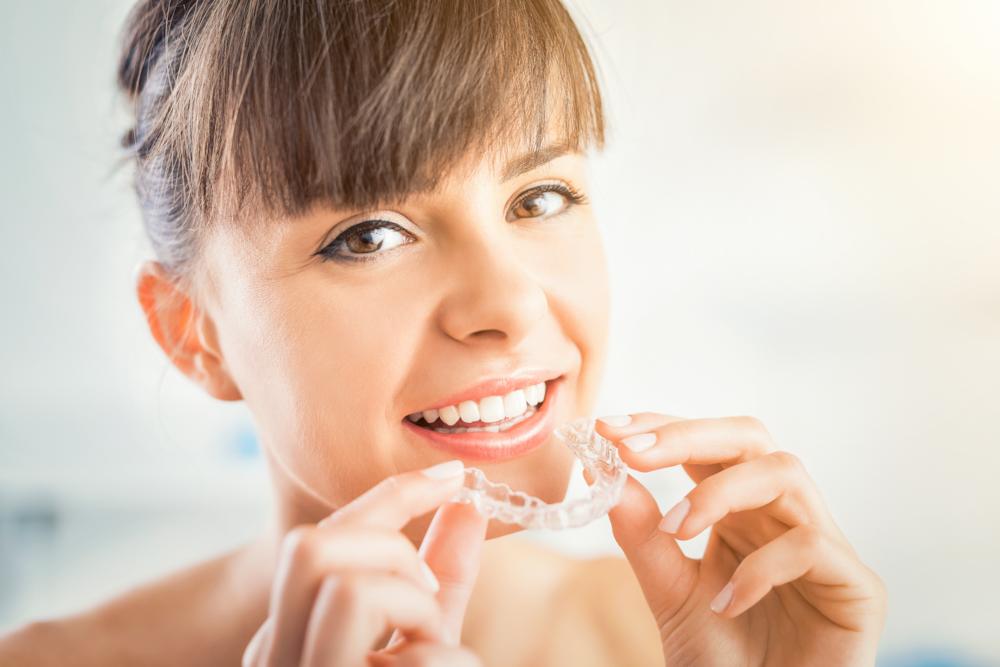Invisalign is a subtle alternative to traditional braces for your orthodontist to use in achieving your confident smile.
Invisalign works as a series of clear trays that gradually straighten your teeth.
As opposed to metal bracket braces, Invisalign trays can be removed at anytime. So feel free to remove trays during special events or pictures. However, in order for them to do their job, the trays must be worn 20-22 hours a day. There is an Invisalign app you can use to keep up with your tray change schedule.
The amount of trays in your Invisalign trays depend on the complexity of your case, but the average care-plan will include about 30 trays.
Your first set of trays will probably be worn for 2 weeks to help you get accustom to wearing them. After the second set, you’ll typically return to your orthodontist to get attachments bonded to your teeth which the trays grip and use as leverage to move the teeth. After this, you will be given about 8-10 weeks worth of trays to change out each week. You don’t have to have another orthodontic appointment again until you’re almost out of trays!
Trays should be removed to eat meals and drink beverages unless they are clear and sugar-free. Teeth should be brushed (or at least swish water) before re-inserting trays.
In order to avoid losing your Invisalign trays, keep them in the provided case instead of wrapping them in a napkin when they’re removed. If you do lose your trays, skip to the next set on the schedule (you may have a little more discomfort than normal). Always keep the previous tray than the one you’re in currently in case you need to use it as a retainer in the event you lose all your trays or need to be re-scanned due to a miss-fit.
Gently brush (or at least rinse) your trays each night with non-whitening toothpaste to keep them fresh. Cleansing crystals or denture cleaning tablets are great for soaking particularly dingy trays. This is especially useful for retainers as the active orthodontic trays are changed out each week, and therefore don’t usually get too dingy during treatment.
Your speech may be affected for the first week or so while your tongue and mouth acclimate to the additional bulk over the teeth. Don’t worry! This is temporary.
Occasionally, a new Invisalign tray will have a rough spot which will rub against the inside of the mouth. Use an Emory board to file the spot until smooth.
It is normal to have some soreness associated with each Invisalign tray change. Sometimes certain teeth will be more sensitive than others during one set. As Invisalign works a little differently than traditional braces, we estimate the discomfort to be about 1/3 that of traditional braces. You may take OTC pain-killers if needed. Do not be alarmed if a tooth seems to be loose. This is a normal part of the process. Do not wiggle the tooth or stop using trays. If you’re ever concerned with the level of discomfort or mobility of your teeth, call your orthodontist and he can examine your teeth and reassure you.
During you’re initial Invisalign delivery, you’re orthodontist will make sure you’re comfortable with inserting and removing your trays and assure that they are fitting properly. You’ll be provided with a “chewy” to bite down on to assure complete and flush settlement. If at any point during treatment you feel a tray is not sitting completely down and cleanly over your teeth, call your orthodontist’s office and have your Invisalign evaluated. Do not ignore ill-fitting Invisalign as this will have a snowball effect which will end with poor results and you may experience unnecessary discomfort.
You can whiten teeth during Invisalign treatment. Your orthodontist should have whitening gel available as an add-on to use in your trays until you reach the desired shade for your teeth.
At the end of treatment you’ll be provided with a thicker, sturdier tray to act as your retainers to keep you’re smile perfect.




